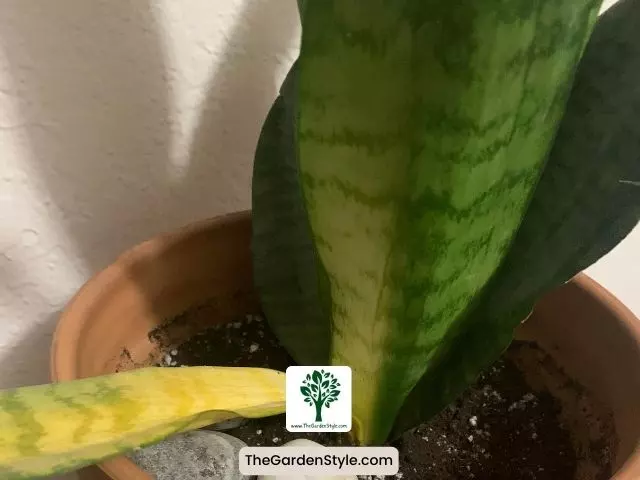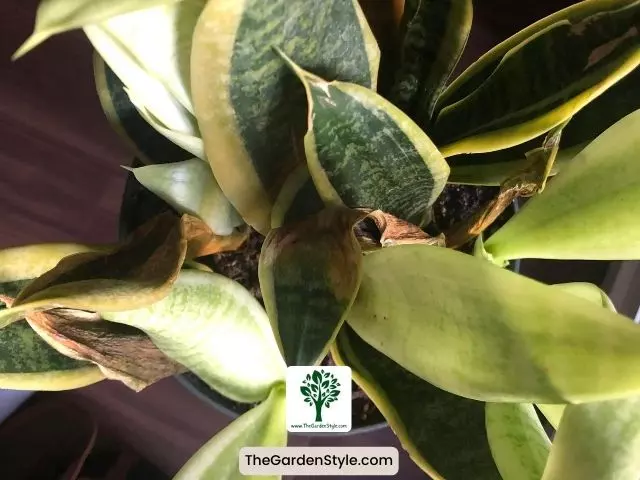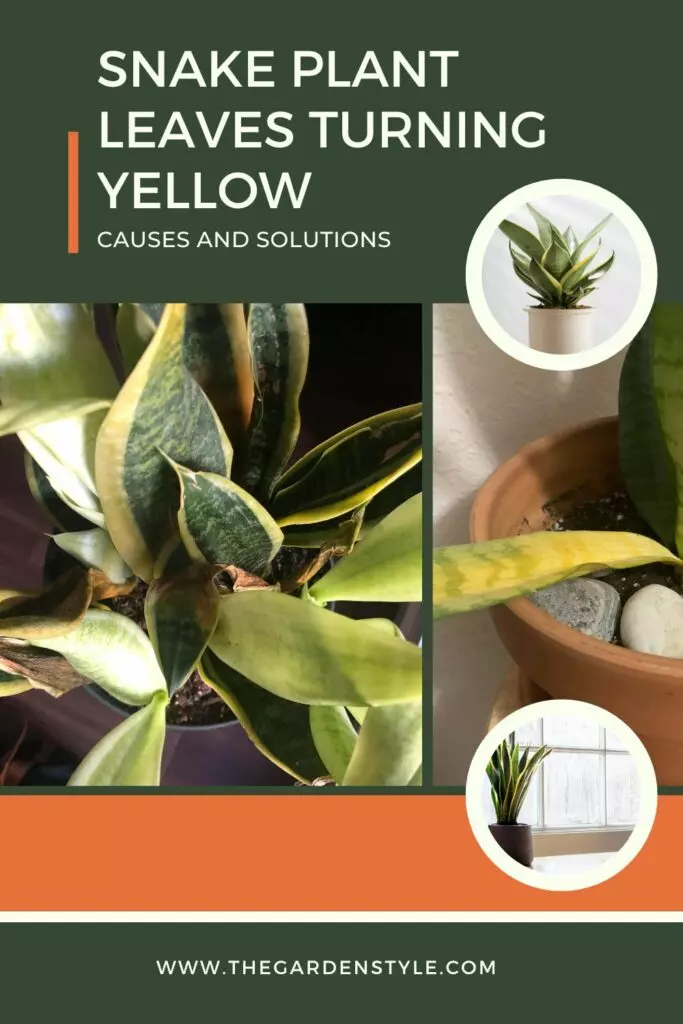Are snake plant leaves turning yellow? Don’t panic yet – with a few easy fixes, you can nurse that plant back to its vibrant glory! In this post, you’ll get to the root (pun intended) of what causes annoying yellow snake plant leaves. I’ll share insider tips to detect whether it just needs a sip of water or is shouting for help. You’ll soon be on your way to a happier, healthier plant baby. Identify the issue, adjust your care techniques, and watch your snake plant healthy again with simple solutions. Get ready to have the happiest snake plant on the block again in no time!
Table of Contents
Why Are My Snake Plant Leaves Turning Yellow?
Suppose you have noticed your snake plant leaves turning yellow. In that case, it is vital to identify the underlying cause to prevent further damage. Here are some possible reasons why your snake plant leaves may be turning yellow:
- Overwatering
- Underwatering
- Sunlight Issues
- Pest and Diseases
- Nutrient Deficiencies
- Natural Aging

Overwatering
Overwatering is one of the most common reasons for snake plant leaves turning yellow. When the soil is too wet, the roots can become damaged and unable to absorb nutrients properly, causing the leaves to turn yellow. That is especially common if the snake plant is in a pot without proper drainage.
What does an overwatered snake plant look like? An overwatered snake plant shows yellowing leaves, wilting, soggy soil, root rot, and leaf edema due to excessive moisture. Learn more about how often to water a snake plant.
Underwatering
On the other hand, if you notice your snake plant leaves turning yellow from the bottom up, it may be a sign of underwatering. When a snake plant doesn’t receive enough water, the leaves will start to turn yellow and brown, starting from the tips and edges.
Sunlight Issues
If your snake plant is not receiving enough sunlight or is exposed to direct sunlight for too long, the leaves may start to turn yellow and brown. That could be due to the plant being placed in a spot that is too dark or too bright.
Pests and Diseases Problems
Another possible reason for snake plant leaves turning yellow is due to pests or diseases. Spider mites, mealybugs, and scale insects can all cause damage to the leaves, leading to yellowing and browning. Fungal diseases such as root rot can also cause yellowing of the leaves.
Nutrient Deficiencies
If your snake plant is not receiving enough nutrients, the leaves may start to turn yellow. That can be due to a lack of nitrogen, iron, or other essential nutrients, which is especially common if you haven’t fertilized your snake plant in a while.
Natural Aging
Finally, it is important to note that snake plant leaves naturally turn yellow and brown as they age. That is a natural process and not a cause for concern unless it is happening too quickly or affecting a large number of leaves.
In the table below, you will find the possible reasons for snake plant leaves turning yellow:
| Possible Issues When Caring for a Snake Plant | Signs and Symptoms |
| Overwatering | Yellowing leaves |
| Underwatering | Yellowing and browning, starting from the tips and edges |
| Sunlight Issues | Yellowing and browning leaves |
| Pests and Diseases Problems | Yellowing and browning, possibly accompanied by other symptoms such as spots, webbing, or holes |
| Nutrient Deficiencies | Yellowing leaves |
| Natural Aging | Yellowing and browning of older leaves |
By identifying the cause of the yellowing leaves, you can take the appropriate steps to remedy the situation and ensure your snake plant stays healthy and vibrant.
How Do I Fix Yellow Leaves on My Snake Plant?
If you have noticed that your snake plant’s leaves are turning yellow, it could indicate a problem with the plant’s health. Here are some steps you can take to fix the issue.

Adjust Watering Based on Diagnoses
One of the most common reasons why snake plant leaves turn yellow is overwatering or underwatering. If the soil is too wet, the roots may rot, leading to yellow and crispy leaves. On the other hand, if the soil is too dry, the plant may not receive enough nutrients, causing the leaves to turn yellow.
To diagnose the problem, check the soil moisture level by sticking your finger about an inch deep into the soil. If the soil feels dry, water the plant thoroughly. If the soil feels wet, hold off on watering for a few days. Additionally, make sure the pot has proper drainage to avoid waterlogging. Learn more about the best soil for a snake plant.
Place The Plant in A Place with Adequate Light
Snake plants require bright, indirect light to thrive. If your plant is not receiving enough light, it may become stressed and develop yellow leaves. Move the plant to a spot with adequate light, but avoid direct sunlight, which can scorch the leaves.
Treat Pests and Diseases
Yellow leaves may also indicate a pest or disease problem. Inspect the plant for signs of pests such as spider mites, mealybugs, or scale insects. If you notice any pests, wipe down the leaves with a damp cloth or treat the plant with an insecticidal soap.
If the plant is suffering from a disease such as root rot or bacterial leaf spot, remove the affected leaves and treat the plant with a fungicide or bactericide.
Use The Appropriate Fertilizer
Finally, yellow leaves may be a sign of nutrient deficiency. Snake plants require minimal fertilization, but if your plant is not receiving enough nutrients, its leaves may turn yellow. Use a balanced fertilizer formulated explicitly for snake plants, such as an NPK fertilizer with a ratio of 6-5-3, and apply it according to the instructions on the package.
This careful application of nutrients can help replenish essential elements and promote healthy growth while addressing the issue of yellowing leaves in your snake plant.
- Give your snake plant every opportunity to grow strong with a little help from Farmer’s Secret.
| Possible Cause | Solution |
| Overwatering | Allow the soil to dry out between waterings |
| Underwatering | Water the plant thoroughly and ensure proper drainage |
| Inadequate Light | Move the plant to a spot with bright, indirect light |
| Pests | Remove pests manually or treat the plant with an insecticidal soap |
| Diseases | Remove affected leaves and treat them with a fungicide or bactericide |
| Nutrient Deficiency | Use a balanced fertilizer formulated for snake plants |

Can Yellow Snake Plant Leaves Turn Green Again?
Yellow snake plant leaves typically don’t revert to their original green color. Once leaves turn yellow, it’s usually a sign of stress, overwatering, or other issues. However, addressing the underlying problem can prevent further yellowing in new growth.
Should I Remove Yellow Leaves from Snake Plant?
Yes, it’s advisable to remove yellow leaves from a snake plant. Trim them at the base to maintain the plant’s aesthetics and prevent the spread of potential diseases or pests. Regularly removing yellow leaves can promote healthier growth.
If this post about snake plant leaves turning yellow was helpful, please share it:




Somebody essentially help to make significantly articles I’d state. This is the first time I frequented your web page and up to now? I surprised with the research you made to make this actual post incredible. Fantastic job!
Thank you so much for your kind words! I’m thrilled to hear that you found the post incredible. I must say, it’s not just my effort – it’s collaborative work with the amazing team at The Garden Style. We’ve put a lot of research and passion into creating content that resonates with our audience. Your encouragement means a lot to all of us. If you have any questions or if there’s anything specific you’d like to see more of on the page, feel free to let us know. We appreciate your support, and we hope you continue to enjoy the content from The Garden Style team!